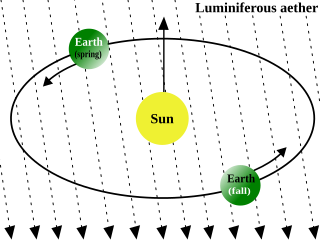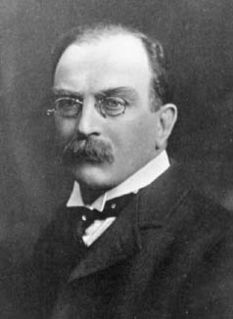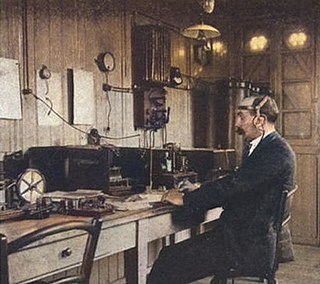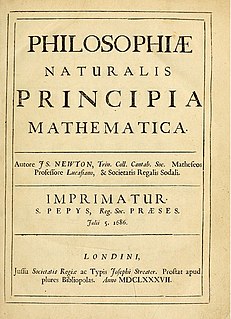
Electromagnetism is a branch of physics involving the study of the electromagnetic force, a type of physical interaction that occurs between electrically charged particles. The electromagnetic force is carried by electromagnetic fields composed of electric fields and magnetic fields, and it is responsible for electromagnetic radiation such as light. It is one of the four fundamental interactions in nature, together with the strong interaction, the weak interaction, and gravitation. At high energy, the weak force and electromagnetic force are unified as a single electroweak force.

Heinrich Rudolf Hertz was a German physicist who first conclusively proved the existence of the electromagnetic waves predicted by James Clerk Maxwell's equations of electromagnetism. The unit of frequency, cycle per second, was named the "hertz" in his honor.

Luminiferous aether or ether was the postulated medium for the propagation of light. It was invoked to explain the ability of the apparently wave-based light to propagate through empty space, something that waves should not be able to do. The assumption of a spatial plenum of luminiferous aether, rather than a spatial vacuum, provided the theoretical medium that was required by wave theories of light.

Maxwell's equations are a set of coupled partial differential equations that, together with the Lorentz force law, form the foundation of classical electromagnetism, classical optics, and electric circuits. The equations provide a mathematical model for electric, optical, and radio technologies, such as power generation, electric motors, wireless communication, lenses, radar etc. They describe how electric and magnetic fields are generated by charges, currents, and changes of the fields. The equations are named after the physicist and mathematician James Clerk Maxwell, who, in 1861 and 1862, published an early form of the equations that included the Lorentz force law. Maxwell first used the equations to propose that light is an electromagnetic phenomenon. The modern form of the equations in their most common formulation is credited to Oliver Heaviside.

Oliver Heaviside FRS was an English mathematician and physicist who brought complex numbers to circuit analysis, invented a new technique for solving differential equations, independently developed vector calculus, and rewrote Maxwell's equations in the form commonly used today. He significantly shaped the way Maxwell's equations are understood and applied in the decades following Maxwell's death. His formulation of the telegrapher's equations became commercially important during his own lifetime, after their significance went unremarked for a long while, as few others were versed at the time in his novel methodology. Although at odds with the scientific establishment for most of his life, Heaviside changed the face of telecommunications, mathematics, and science.

Longitudinal waves are waves in which the vibration of the medium is parallel to the direction the wave travels and displacement of the medium is in the same direction of the wave propagation. Mechanical longitudinal waves are also called compressional or compression waves, because they produce compression and rarefaction when traveling through a medium, and pressure waves, because they produce increases and decreases in pressure. A wave along the length of a stretched Slinky toy, where the distance between coils increases and decreases, is a good visualization. Real-world examples include sound waves and seismic P-waves.

Sir Oliver Joseph Lodge, was a British physicist and writer involved in the development of, and holder of key patents for, radio. He identified electromagnetic radiation independent of Hertz's proof and at his 1894 Royal Institution lectures, Lodge demonstrated an early radio wave detector he named the "coherer". In 1898 he was awarded the "syntonic" patent by the United States Patent Office. Lodge was Principal of the University of Birmingham from 1900 to 1920.

Prof George Francis FitzGerald was an Irish academic and physicist who served as Erasmus Smith's Professor of Natural and Experimental Philosophy at Trinity College Dublin (TCD) from 1881 to 1901.

Sir Joseph Larmor was an Irish and British physicist and mathematician who made breakthroughs in the understanding of electricity, dynamics, thermodynamics, and the electron theory of matter. His most influential work was Aether and Matter, a theoretical physics book published in 1900.

A Treatise on Electricity and Magnetism is a two-volume treatise on electromagnetism written by James Clerk Maxwell in 1873. Maxwell was revising the Treatise for a second edition when he died in 1879. The revision was completed by William Davidson Niven for publication in 1881. A third edition was prepared by J. J. Thomson for publication in 1892.
In physics, the electric displacement field or electric induction is a vector field that appears in Maxwell's equations. It accounts for the effects of free and bound charge within materials. "D" stands for "displacement", as in the related concept of displacement current in dielectrics. In free space, the electric displacement field is equivalent to flux density, a concept that lends understanding of Gauss's law. In the International System of Units (SI), it is expressed in units of coulomb per meter square (C⋅m−2).
The history of special relativity consists of many theoretical results and empirical findings obtained by Albert A. Michelson, Hendrik Lorentz, Henri Poincaré and others. It culminated in the theory of special relativity proposed by Albert Einstein and subsequent work of Max Planck, Hermann Minkowski and others.

The Annus mirabilis papers are the four papers that Albert Einstein published in Annalen der Physik, a scientific journal, in 1905. These four papers were major contributions to the foundation of modern physics. They revolutionized science's understanding of the fundamental concepts of space, time, mass, and energy. Because Einstein published these remarkable papers in a single year, 1905 is called his annus mirabilis.
In physics, aether theories propose the existence of a medium, a space-filling substance or field as a transmission medium for the propagation of electromagnetic or gravitational forces. Since the development of special relativity, theories using a substantial aether fell out of use in modern physics, and are now replaced by more abstract models.
Energy current is a flow of energy defined by the Poynting vector, as opposed to normal current. It was originally postulated by Oliver Heaviside. It is also an informal name for Energy flux.

The invention of radio communication spanned many decades of establishing theoretical underpinnings, discovery and experimental investigation of radio waves, and engineering and technical developments related to their transmission and detection. This scientific work preceded Guglielmo Marconi's use of radio waves in a wireless communication system.
The Electrician, published in London from 1861–1863 and 1878–1952, was the one of the earliest and foremost electrical engineering periodicals and scientific journals. It was published in two series: The original Electrician was published for three years from 1861–1863. After a fifteen year gap, a new series of the Electrician was in print for 72 years from 1878–1952. The Electrician is currently remembered as the publisher of Oliver Heaviside's works, in particular the first publication of the telegrapher's equations, still in wide use for radio engineering.

A treatise is a formal and systematic written discourse on some subject, generally longer and treating it in greater depth than an essay, and more concerned with investigating or exposing the principles of the subject and its conclusions. A monograph is a treatise on a specialized topic.
"On Physical Lines of Force" is a four-part paper written by James Clerk Maxwell published in 1861. In it, Maxwell derived the equations of electromagnetism in conjunction with a "sea" of "molecular vortices" which he used to model Faraday's lines of force. Maxwell had studied and commented on the field of electricity and magnetism as early as 1855/6 when "On Faraday's Lines of Force" was read to the Cambridge Philosophical Society. Maxwell made an analogy between the density of this medium and the magnetic permeability, as well as an analogy between the transverse elasticity and the dielectric constant, and using the results of a prior experiment by Wilhelm Eduard Weber and Rudolf Kohlrausch performed in 1856, he established a connection between the speed of light and the speed of propagation of waves in this medium.

In the beginning of the 19th century, many experimental and theoretical works had been accomplished in the understanding of electromagnetics. In the 1780s, Coulomb's law of electrostatics had been established. In 1825, Ampère published his Ampère's law. Michael Faraday discovered the electromagnetic induction through his experiments and conceptually, he emphasized the lines of forces in this electromagnetic induction. In 1834, Lenz solved the problem of the direction of the induction, and Neumann wrote down the equation to calculate the induced force by change of magnetic flux. However, these experimental results and rules were not well organized and sometimes confusing to scientists. A comprehensive summary of the electrodynamic principles was in urgent need at that time.














